Business Environment: Industry Analysis Factsheet & Audit Portfolio
VerifiedAdded on 2023/06/18
|19
|4207
|147
Report
AI Summary
This report provides an in-depth analysis of the business environment, focusing on industry analysis through a factsheet and environmental business audit. It covers various types of organizations within the sports industry, including private (Nike), public (JD Sports), and voluntary sectors (Community Amateur Sports Club). The report discusses the legal structures, sizes, scopes, visions, missions, and objectives of these organizations. A stakeholder analysis is conducted, and an organizational functional structure flow chart is presented. Furthermore, the report examines how internal departments like finance and marketing collaborate to meet business objectives, highlighting the interrelation between human resources, IT, and finance. The conclusion emphasizes the critical role of the business environment and the importance of conducting SWOT and PESTEL analyses for effective decision-making and company growth. The document is available on Desklib, a platform offering a wide range of study tools and solved assignments for students.
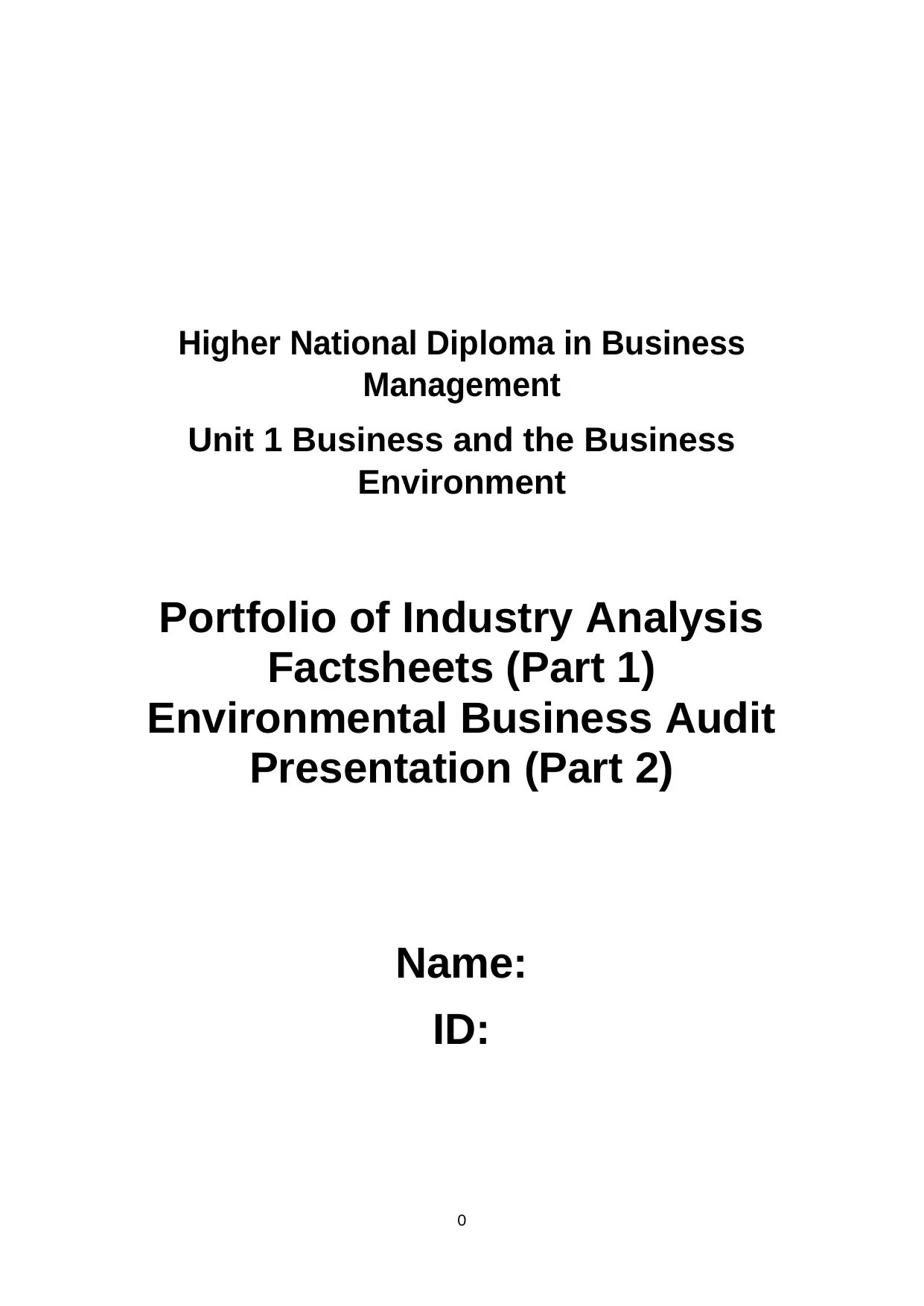
Higher National Diploma in Business
Management
Unit 1 Business and the Business
Environment
Portfolio of Industry Analysis
Factsheets (Part 1)
Environmental Business Audit
Presentation (Part 2)
Name:
ID:
0
Management
Unit 1 Business and the Business
Environment
Portfolio of Industry Analysis
Factsheets (Part 1)
Environmental Business Audit
Presentation (Part 2)
Name:
ID:
0
Paraphrase This Document
Need a fresh take? Get an instant paraphrase of this document with our AI Paraphraser
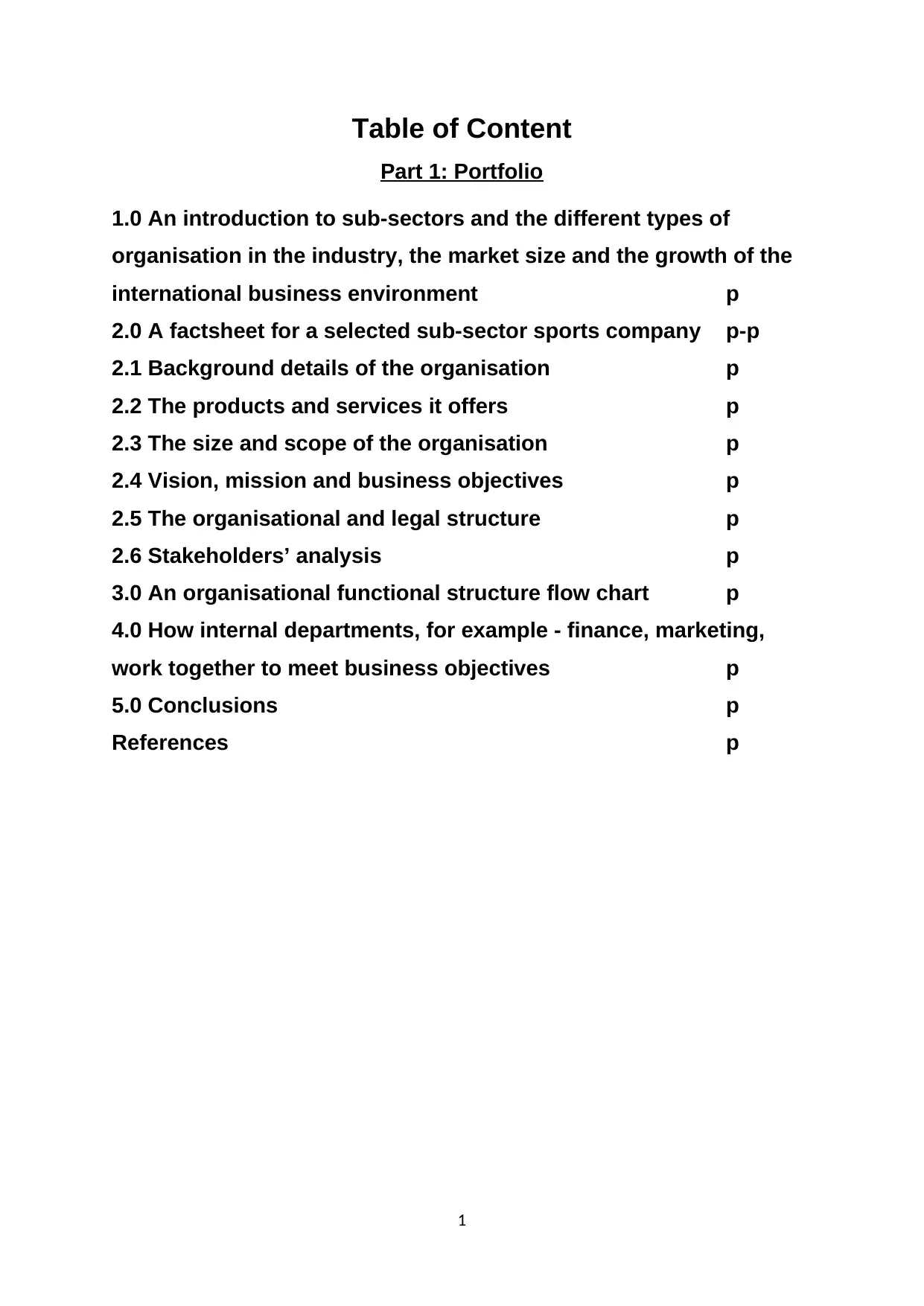
Table of Content
Part 1: Portfolio
1.0 An introduction to sub-sectors and the different types of
organisation in the industry, the market size and the growth of the
international business environment p
2.0 A factsheet for a selected sub-sector sports company p-p
2.1 Background details of the organisation p
2.2 The products and services it offers p
2.3 The size and scope of the organisation p
2.4 Vision, mission and business objectives p
2.5 The organisational and legal structure p
2.6 Stakeholders’ analysis p
3.0 An organisational functional structure flow chart p
4.0 How internal departments, for example - finance, marketing,
work together to meet business objectives p
5.0 Conclusions p
References p
1
Part 1: Portfolio
1.0 An introduction to sub-sectors and the different types of
organisation in the industry, the market size and the growth of the
international business environment p
2.0 A factsheet for a selected sub-sector sports company p-p
2.1 Background details of the organisation p
2.2 The products and services it offers p
2.3 The size and scope of the organisation p
2.4 Vision, mission and business objectives p
2.5 The organisational and legal structure p
2.6 Stakeholders’ analysis p
3.0 An organisational functional structure flow chart p
4.0 How internal departments, for example - finance, marketing,
work together to meet business objectives p
5.0 Conclusions p
References p
1
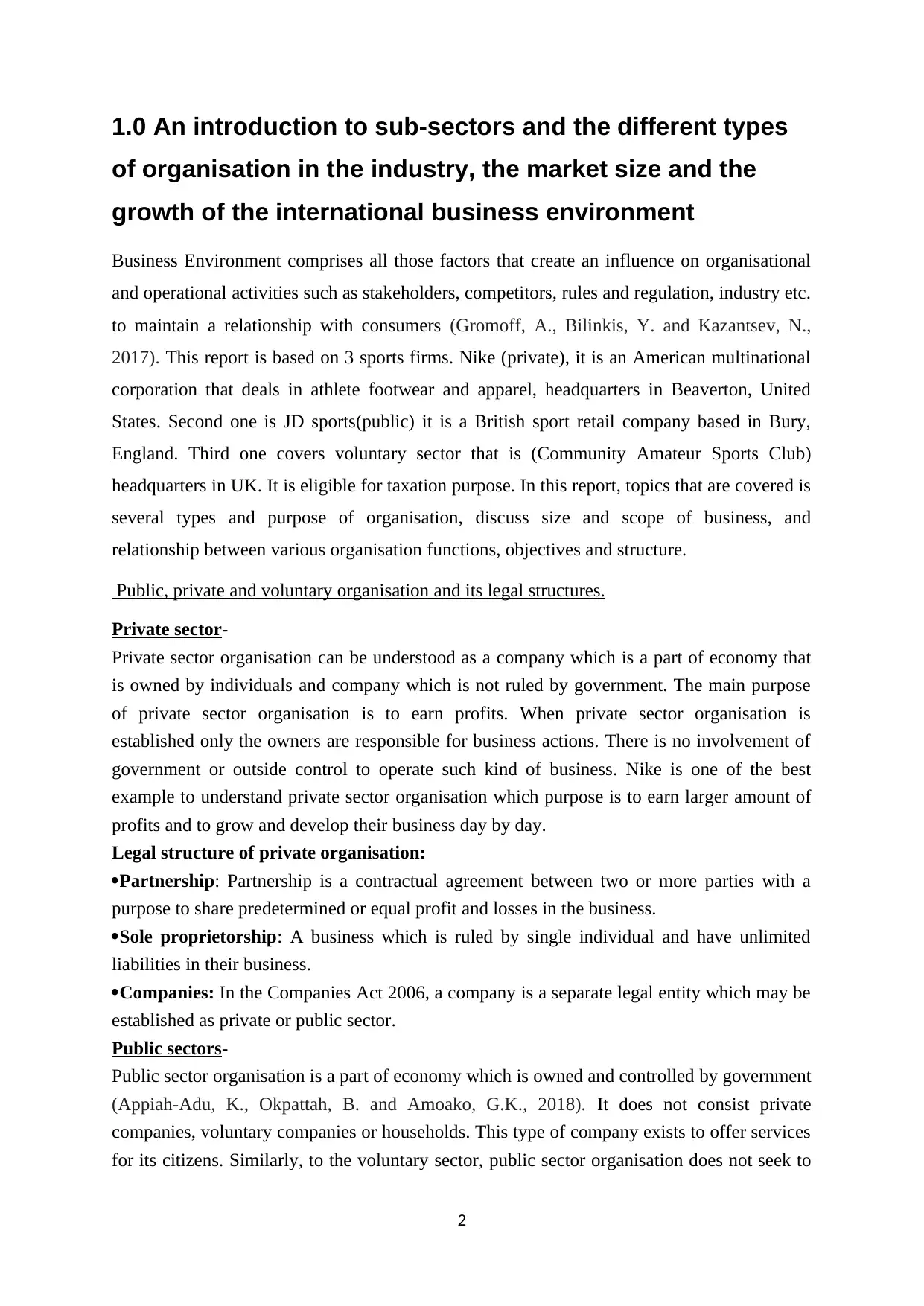
1.0 An introduction to sub-sectors and the different types
of organisation in the industry, the market size and the
growth of the international business environment
Business Environment comprises all those factors that create an influence on organisational
and operational activities such as stakeholders, competitors, rules and regulation, industry etc.
to maintain a relationship with consumers (Gromoff, A., Bilinkis, Y. and Kazantsev, N.,
2017). This report is based on 3 sports firms. Nike (private), it is an American multinational
corporation that deals in athlete footwear and apparel, headquarters in Beaverton, United
States. Second one is JD sports(public) it is a British sport retail company based in Bury,
England. Third one covers voluntary sector that is (Community Amateur Sports Club)
headquarters in UK. It is eligible for taxation purpose. In this report, topics that are covered is
several types and purpose of organisation, discuss size and scope of business, and
relationship between various organisation functions, objectives and structure.
Public, private and voluntary organisation and its legal structures.
Private sector-
Private sector organisation can be understood as a company which is a part of economy that
is owned by individuals and company which is not ruled by government. The main purpose
of private sector organisation is to earn profits. When private sector organisation is
established only the owners are responsible for business actions. There is no involvement of
government or outside control to operate such kind of business. Nike is one of the best
example to understand private sector organisation which purpose is to earn larger amount of
profits and to grow and develop their business day by day.
Legal structure of private organisation:
Partnership: Partnership is a contractual agreement between two or more parties with a
purpose to share predetermined or equal profit and losses in the business.
Sole proprietorship: A business which is ruled by single individual and have unlimited
liabilities in their business.
Companies: In the Companies Act 2006, a company is a separate legal entity which may be
established as private or public sector.
Public sectors-
Public sector organisation is a part of economy which is owned and controlled by government
(Appiah-Adu, K., Okpattah, B. and Amoako, G.K., 2018). It does not consist private
companies, voluntary companies or households. This type of company exists to offer services
for its citizens. Similarly, to the voluntary sector, public sector organisation does not seek to
2
of organisation in the industry, the market size and the
growth of the international business environment
Business Environment comprises all those factors that create an influence on organisational
and operational activities such as stakeholders, competitors, rules and regulation, industry etc.
to maintain a relationship with consumers (Gromoff, A., Bilinkis, Y. and Kazantsev, N.,
2017). This report is based on 3 sports firms. Nike (private), it is an American multinational
corporation that deals in athlete footwear and apparel, headquarters in Beaverton, United
States. Second one is JD sports(public) it is a British sport retail company based in Bury,
England. Third one covers voluntary sector that is (Community Amateur Sports Club)
headquarters in UK. It is eligible for taxation purpose. In this report, topics that are covered is
several types and purpose of organisation, discuss size and scope of business, and
relationship between various organisation functions, objectives and structure.
Public, private and voluntary organisation and its legal structures.
Private sector-
Private sector organisation can be understood as a company which is a part of economy that
is owned by individuals and company which is not ruled by government. The main purpose
of private sector organisation is to earn profits. When private sector organisation is
established only the owners are responsible for business actions. There is no involvement of
government or outside control to operate such kind of business. Nike is one of the best
example to understand private sector organisation which purpose is to earn larger amount of
profits and to grow and develop their business day by day.
Legal structure of private organisation:
Partnership: Partnership is a contractual agreement between two or more parties with a
purpose to share predetermined or equal profit and losses in the business.
Sole proprietorship: A business which is ruled by single individual and have unlimited
liabilities in their business.
Companies: In the Companies Act 2006, a company is a separate legal entity which may be
established as private or public sector.
Public sectors-
Public sector organisation is a part of economy which is owned and controlled by government
(Appiah-Adu, K., Okpattah, B. and Amoako, G.K., 2018). It does not consist private
companies, voluntary companies or households. This type of company exists to offer services
for its citizens. Similarly, to the voluntary sector, public sector organisation does not seek to
2
⊘ This is a preview!⊘
Do you want full access?
Subscribe today to unlock all pages.

Trusted by 1+ million students worldwide
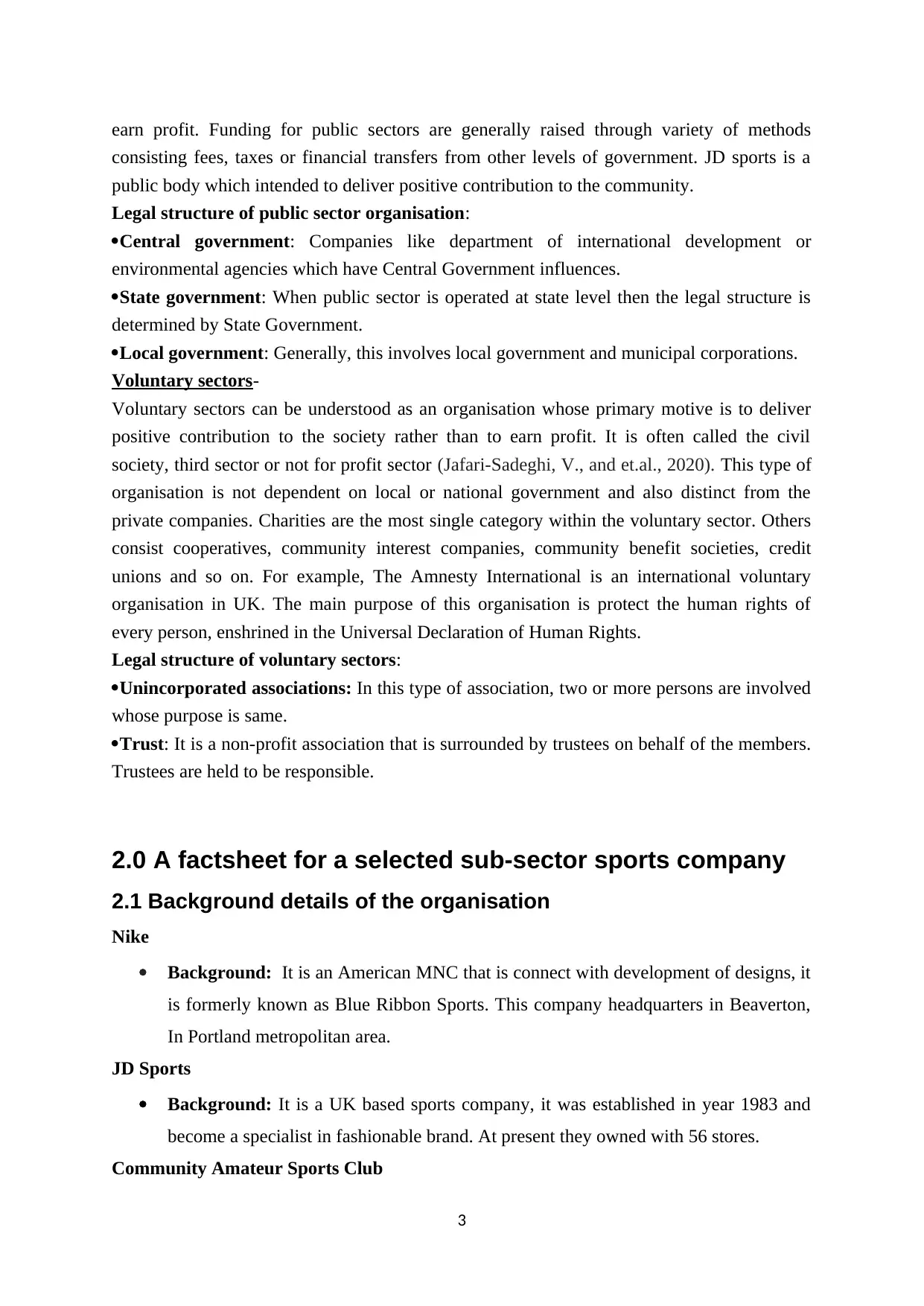
earn profit. Funding for public sectors are generally raised through variety of methods
consisting fees, taxes or financial transfers from other levels of government. JD sports is a
public body which intended to deliver positive contribution to the community.
Legal structure of public sector organisation:
Central government: Companies like department of international development or
environmental agencies which have Central Government influences.
State government: When public sector is operated at state level then the legal structure is
determined by State Government.
Local government: Generally, this involves local government and municipal corporations.
Voluntary sectors-
Voluntary sectors can be understood as an organisation whose primary motive is to deliver
positive contribution to the society rather than to earn profit. It is often called the civil
society, third sector or not for profit sector (Jafari-Sadeghi, V., and et.al., 2020). This type of
organisation is not dependent on local or national government and also distinct from the
private companies. Charities are the most single category within the voluntary sector. Others
consist cooperatives, community interest companies, community benefit societies, credit
unions and so on. For example, The Amnesty International is an international voluntary
organisation in UK. The main purpose of this organisation is protect the human rights of
every person, enshrined in the Universal Declaration of Human Rights.
Legal structure of voluntary sectors:
Unincorporated associations: In this type of association, two or more persons are involved
whose purpose is same.
Trust: It is a non-profit association that is surrounded by trustees on behalf of the members.
Trustees are held to be responsible.
2.0 A factsheet for a selected sub-sector sports company
2.1 Background details of the organisation
Nike
Background: It is an American MNC that is connect with development of designs, it
is formerly known as Blue Ribbon Sports. This company headquarters in Beaverton,
In Portland metropolitan area.
JD Sports
Background: It is a UK based sports company, it was established in year 1983 and
become a specialist in fashionable brand. At present they owned with 56 stores.
Community Amateur Sports Club
3
consisting fees, taxes or financial transfers from other levels of government. JD sports is a
public body which intended to deliver positive contribution to the community.
Legal structure of public sector organisation:
Central government: Companies like department of international development or
environmental agencies which have Central Government influences.
State government: When public sector is operated at state level then the legal structure is
determined by State Government.
Local government: Generally, this involves local government and municipal corporations.
Voluntary sectors-
Voluntary sectors can be understood as an organisation whose primary motive is to deliver
positive contribution to the society rather than to earn profit. It is often called the civil
society, third sector or not for profit sector (Jafari-Sadeghi, V., and et.al., 2020). This type of
organisation is not dependent on local or national government and also distinct from the
private companies. Charities are the most single category within the voluntary sector. Others
consist cooperatives, community interest companies, community benefit societies, credit
unions and so on. For example, The Amnesty International is an international voluntary
organisation in UK. The main purpose of this organisation is protect the human rights of
every person, enshrined in the Universal Declaration of Human Rights.
Legal structure of voluntary sectors:
Unincorporated associations: In this type of association, two or more persons are involved
whose purpose is same.
Trust: It is a non-profit association that is surrounded by trustees on behalf of the members.
Trustees are held to be responsible.
2.0 A factsheet for a selected sub-sector sports company
2.1 Background details of the organisation
Nike
Background: It is an American MNC that is connect with development of designs, it
is formerly known as Blue Ribbon Sports. This company headquarters in Beaverton,
In Portland metropolitan area.
JD Sports
Background: It is a UK based sports company, it was established in year 1983 and
become a specialist in fashionable brand. At present they owned with 56 stores.
Community Amateur Sports Club
3
Paraphrase This Document
Need a fresh take? Get an instant paraphrase of this document with our AI Paraphraser
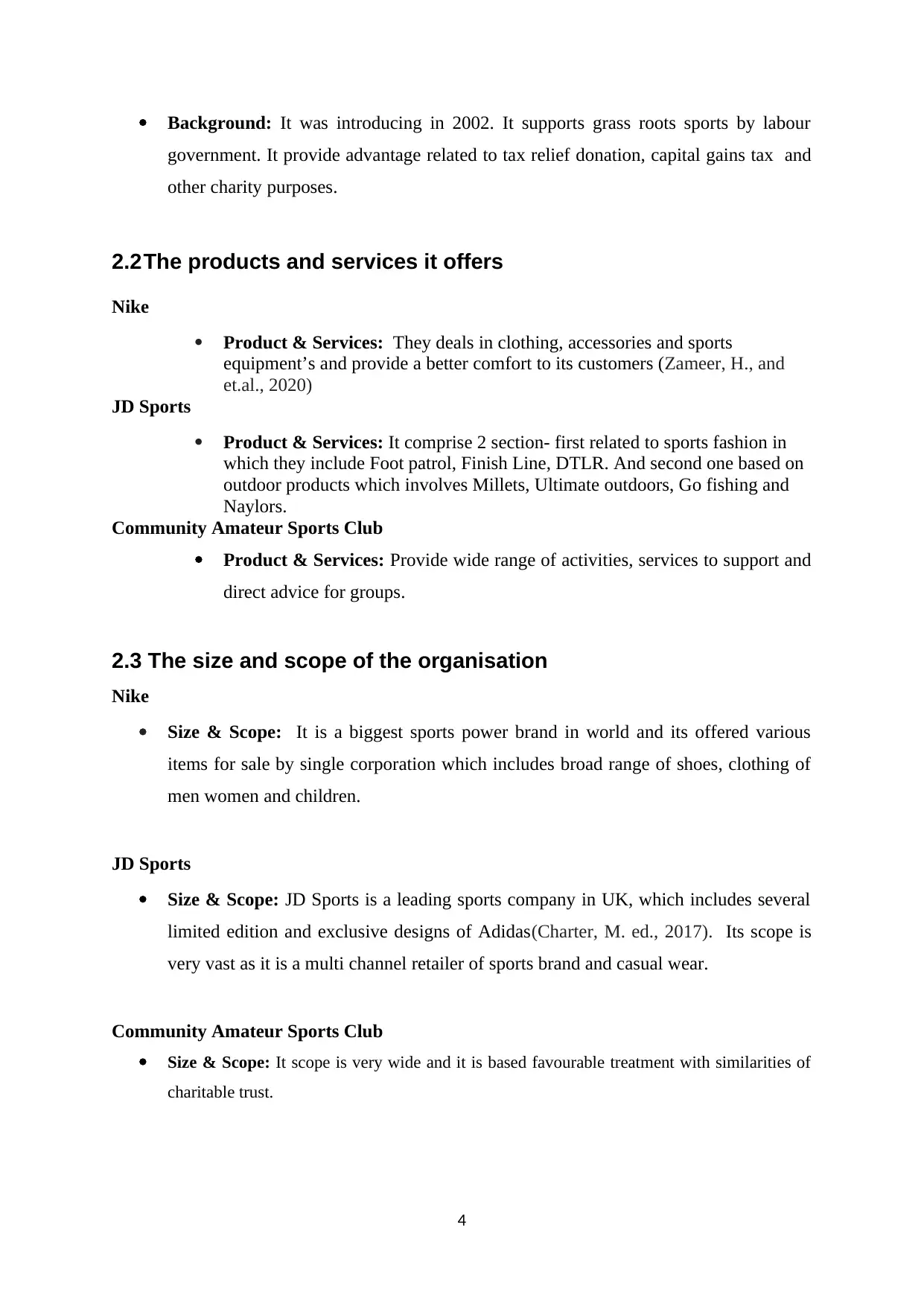
Background: It was introducing in 2002. It supports grass roots sports by labour
government. It provide advantage related to tax relief donation, capital gains tax and
other charity purposes.
2.2The products and services it offers
Nike
Product & Services: They deals in clothing, accessories and sports
equipment’s and provide a better comfort to its customers (Zameer, H., and
et.al., 2020)
JD Sports
Product & Services: It comprise 2 section- first related to sports fashion in
which they include Foot patrol, Finish Line, DTLR. And second one based on
outdoor products which involves Millets, Ultimate outdoors, Go fishing and
Naylors.
Community Amateur Sports Club
Product & Services: Provide wide range of activities, services to support and
direct advice for groups.
2.3 The size and scope of the organisation
Nike
Size & Scope: It is a biggest sports power brand in world and its offered various
items for sale by single corporation which includes broad range of shoes, clothing of
men women and children.
JD Sports
Size & Scope: JD Sports is a leading sports company in UK, which includes several
limited edition and exclusive designs of Adidas(Charter, M. ed., 2017). Its scope is
very vast as it is a multi channel retailer of sports brand and casual wear.
Community Amateur Sports Club
Size & Scope: It scope is very wide and it is based favourable treatment with similarities of
charitable trust.
4
government. It provide advantage related to tax relief donation, capital gains tax and
other charity purposes.
2.2The products and services it offers
Nike
Product & Services: They deals in clothing, accessories and sports
equipment’s and provide a better comfort to its customers (Zameer, H., and
et.al., 2020)
JD Sports
Product & Services: It comprise 2 section- first related to sports fashion in
which they include Foot patrol, Finish Line, DTLR. And second one based on
outdoor products which involves Millets, Ultimate outdoors, Go fishing and
Naylors.
Community Amateur Sports Club
Product & Services: Provide wide range of activities, services to support and
direct advice for groups.
2.3 The size and scope of the organisation
Nike
Size & Scope: It is a biggest sports power brand in world and its offered various
items for sale by single corporation which includes broad range of shoes, clothing of
men women and children.
JD Sports
Size & Scope: JD Sports is a leading sports company in UK, which includes several
limited edition and exclusive designs of Adidas(Charter, M. ed., 2017). Its scope is
very vast as it is a multi channel retailer of sports brand and casual wear.
Community Amateur Sports Club
Size & Scope: It scope is very wide and it is based favourable treatment with similarities of
charitable trust.
4
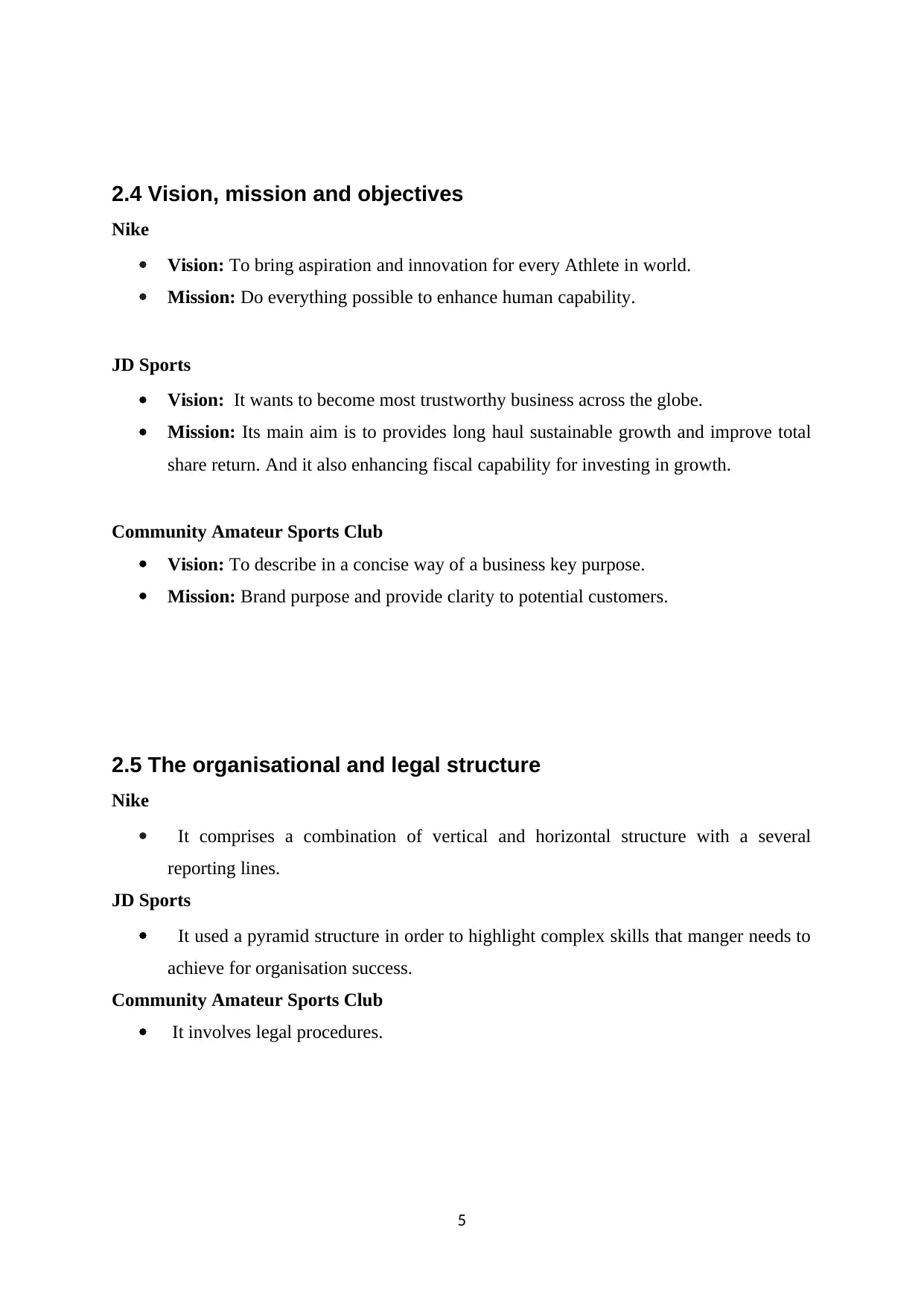
2.4 Vision, mission and objectives
Nike
Vision: To bring aspiration and innovation for every Athlete in world.
Mission: Do everything possible to enhance human capability.
JD Sports
Vision: It wants to become most trustworthy business across the globe.
Mission: Its main aim is to provides long haul sustainable growth and improve total
share return. And it also enhancing fiscal capability for investing in growth.
Community Amateur Sports Club
Vision: To describe in a concise way of a business key purpose.
Mission: Brand purpose and provide clarity to potential customers.
2.5 The organisational and legal structure
Nike
It comprises a combination of vertical and horizontal structure with a several
reporting lines.
JD Sports
It used a pyramid structure in order to highlight complex skills that manger needs to
achieve for organisation success.
Community Amateur Sports Club
It involves legal procedures.
5
Nike
Vision: To bring aspiration and innovation for every Athlete in world.
Mission: Do everything possible to enhance human capability.
JD Sports
Vision: It wants to become most trustworthy business across the globe.
Mission: Its main aim is to provides long haul sustainable growth and improve total
share return. And it also enhancing fiscal capability for investing in growth.
Community Amateur Sports Club
Vision: To describe in a concise way of a business key purpose.
Mission: Brand purpose and provide clarity to potential customers.
2.5 The organisational and legal structure
Nike
It comprises a combination of vertical and horizontal structure with a several
reporting lines.
JD Sports
It used a pyramid structure in order to highlight complex skills that manger needs to
achieve for organisation success.
Community Amateur Sports Club
It involves legal procedures.
5
⊘ This is a preview!⊘
Do you want full access?
Subscribe today to unlock all pages.

Trusted by 1+ million students worldwide
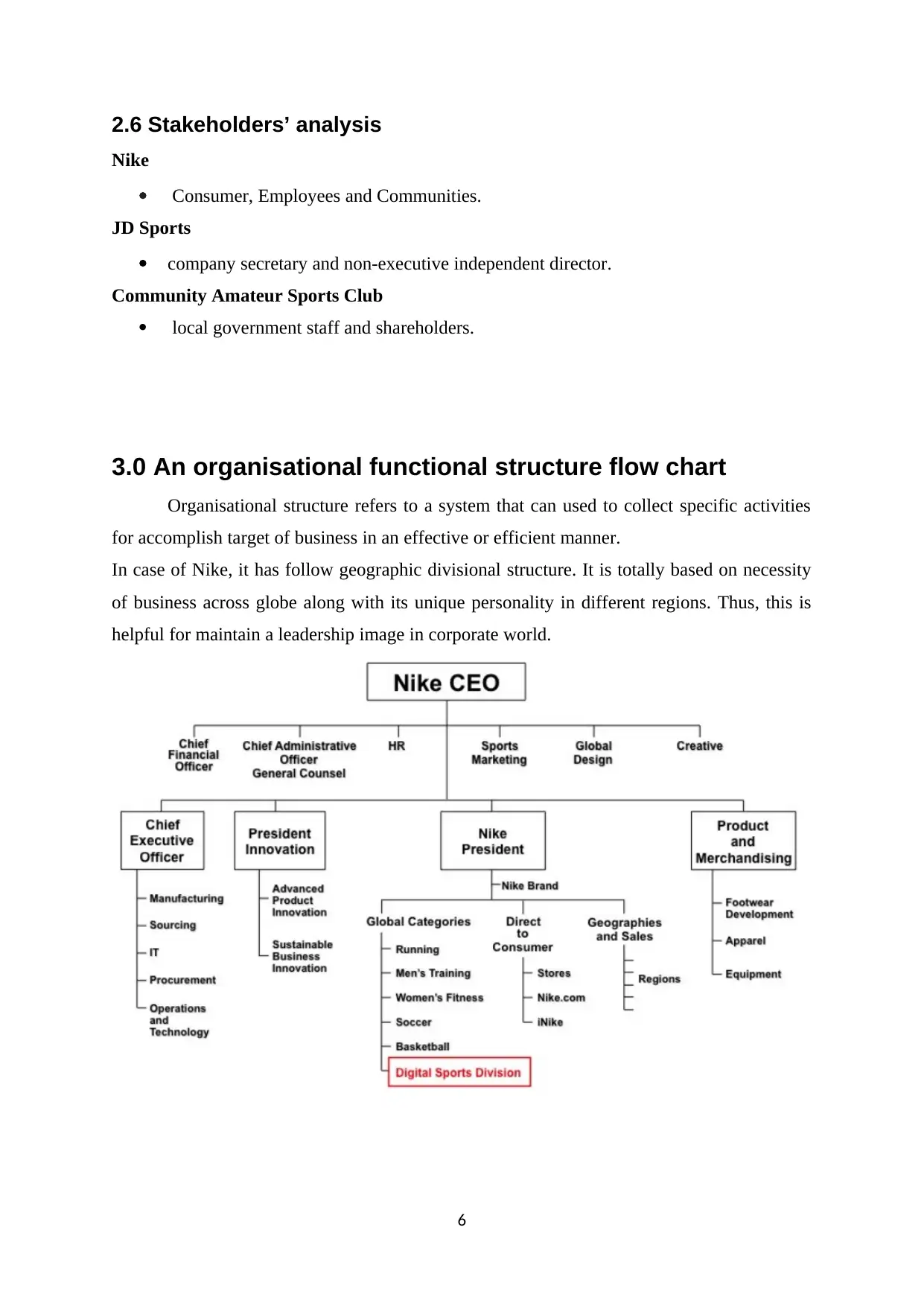
2.6 Stakeholders’ analysis
Nike
Consumer, Employees and Communities.
JD Sports
company secretary and non-executive independent director.
Community Amateur Sports Club
local government staff and shareholders.
3.0 An organisational functional structure flow chart
Organisational structure refers to a system that can used to collect specific activities
for accomplish target of business in an effective or efficient manner.
In case of Nike, it has follow geographic divisional structure. It is totally based on necessity
of business across globe along with its unique personality in different regions. Thus, this is
helpful for maintain a leadership image in corporate world.
6
Nike
Consumer, Employees and Communities.
JD Sports
company secretary and non-executive independent director.
Community Amateur Sports Club
local government staff and shareholders.
3.0 An organisational functional structure flow chart
Organisational structure refers to a system that can used to collect specific activities
for accomplish target of business in an effective or efficient manner.
In case of Nike, it has follow geographic divisional structure. It is totally based on necessity
of business across globe along with its unique personality in different regions. Thus, this is
helpful for maintain a leadership image in corporate world.
6
Paraphrase This Document
Need a fresh take? Get an instant paraphrase of this document with our AI Paraphraser
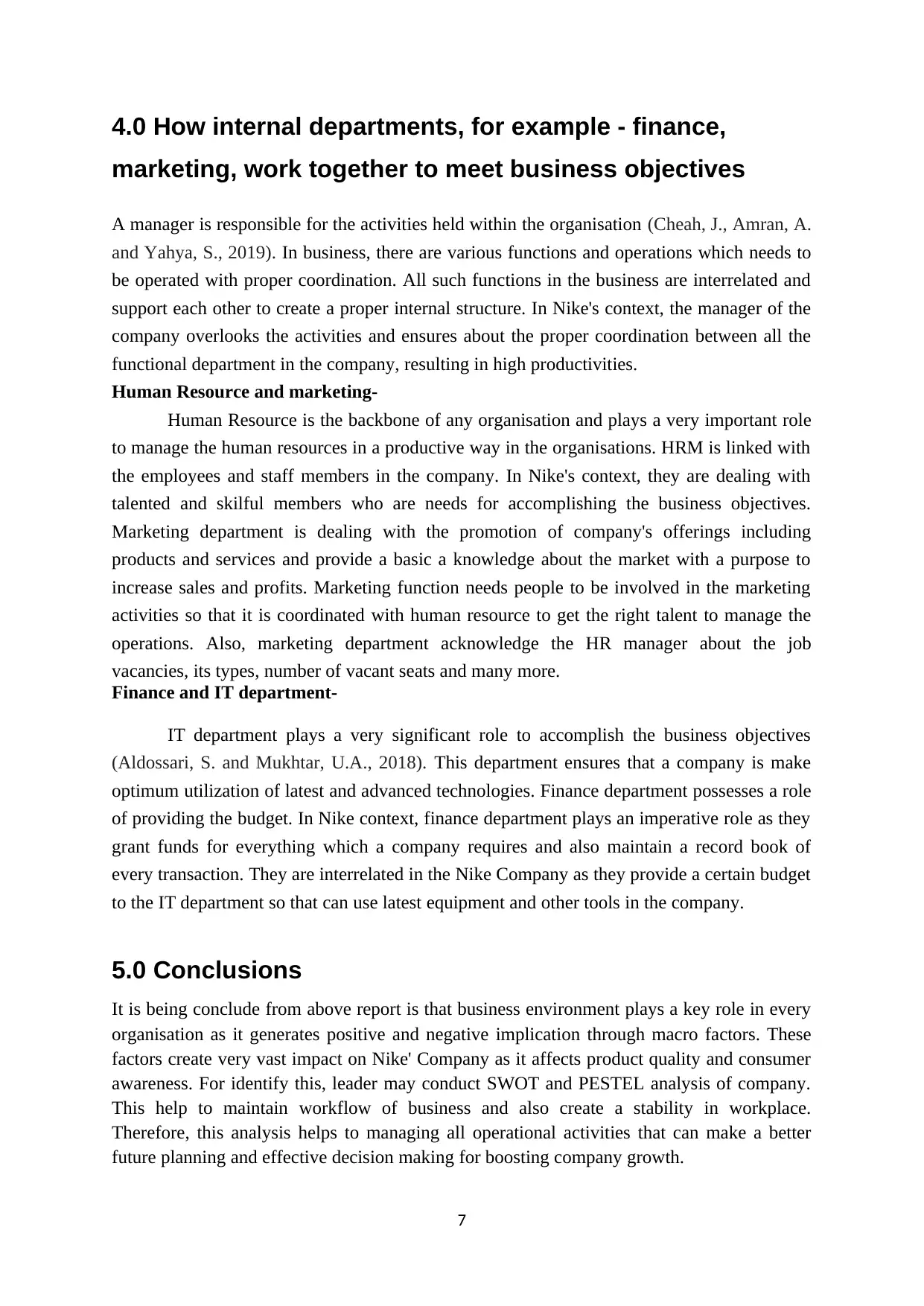
4.0 How internal departments, for example - finance,
marketing, work together to meet business objectives
A manager is responsible for the activities held within the organisation (Cheah, J., Amran, A.
and Yahya, S., 2019). In business, there are various functions and operations which needs to
be operated with proper coordination. All such functions in the business are interrelated and
support each other to create a proper internal structure. In Nike's context, the manager of the
company overlooks the activities and ensures about the proper coordination between all the
functional department in the company, resulting in high productivities.
Human Resource and marketing-
Human Resource is the backbone of any organisation and plays a very important role
to manage the human resources in a productive way in the organisations. HRM is linked with
the employees and staff members in the company. In Nike's context, they are dealing with
talented and skilful members who are needs for accomplishing the business objectives.
Marketing department is dealing with the promotion of company's offerings including
products and services and provide a basic a knowledge about the market with a purpose to
increase sales and profits. Marketing function needs people to be involved in the marketing
activities so that it is coordinated with human resource to get the right talent to manage the
operations. Also, marketing department acknowledge the HR manager about the job
vacancies, its types, number of vacant seats and many more.
Finance and IT department-
IT department plays a very significant role to accomplish the business objectives
(Aldossari, S. and Mukhtar, U.A., 2018). This department ensures that a company is make
optimum utilization of latest and advanced technologies. Finance department possesses a role
of providing the budget. In Nike context, finance department plays an imperative role as they
grant funds for everything which a company requires and also maintain a record book of
every transaction. They are interrelated in the Nike Company as they provide a certain budget
to the IT department so that can use latest equipment and other tools in the company.
5.0 Conclusions
It is being conclude from above report is that business environment plays a key role in every
organisation as it generates positive and negative implication through macro factors. These
factors create very vast impact on Nike' Company as it affects product quality and consumer
awareness. For identify this, leader may conduct SWOT and PESTEL analysis of company.
This help to maintain workflow of business and also create a stability in workplace.
Therefore, this analysis helps to managing all operational activities that can make a better
future planning and effective decision making for boosting company growth.
7
marketing, work together to meet business objectives
A manager is responsible for the activities held within the organisation (Cheah, J., Amran, A.
and Yahya, S., 2019). In business, there are various functions and operations which needs to
be operated with proper coordination. All such functions in the business are interrelated and
support each other to create a proper internal structure. In Nike's context, the manager of the
company overlooks the activities and ensures about the proper coordination between all the
functional department in the company, resulting in high productivities.
Human Resource and marketing-
Human Resource is the backbone of any organisation and plays a very important role
to manage the human resources in a productive way in the organisations. HRM is linked with
the employees and staff members in the company. In Nike's context, they are dealing with
talented and skilful members who are needs for accomplishing the business objectives.
Marketing department is dealing with the promotion of company's offerings including
products and services and provide a basic a knowledge about the market with a purpose to
increase sales and profits. Marketing function needs people to be involved in the marketing
activities so that it is coordinated with human resource to get the right talent to manage the
operations. Also, marketing department acknowledge the HR manager about the job
vacancies, its types, number of vacant seats and many more.
Finance and IT department-
IT department plays a very significant role to accomplish the business objectives
(Aldossari, S. and Mukhtar, U.A., 2018). This department ensures that a company is make
optimum utilization of latest and advanced technologies. Finance department possesses a role
of providing the budget. In Nike context, finance department plays an imperative role as they
grant funds for everything which a company requires and also maintain a record book of
every transaction. They are interrelated in the Nike Company as they provide a certain budget
to the IT department so that can use latest equipment and other tools in the company.
5.0 Conclusions
It is being conclude from above report is that business environment plays a key role in every
organisation as it generates positive and negative implication through macro factors. These
factors create very vast impact on Nike' Company as it affects product quality and consumer
awareness. For identify this, leader may conduct SWOT and PESTEL analysis of company.
This help to maintain workflow of business and also create a stability in workplace.
Therefore, this analysis helps to managing all operational activities that can make a better
future planning and effective decision making for boosting company growth.
7
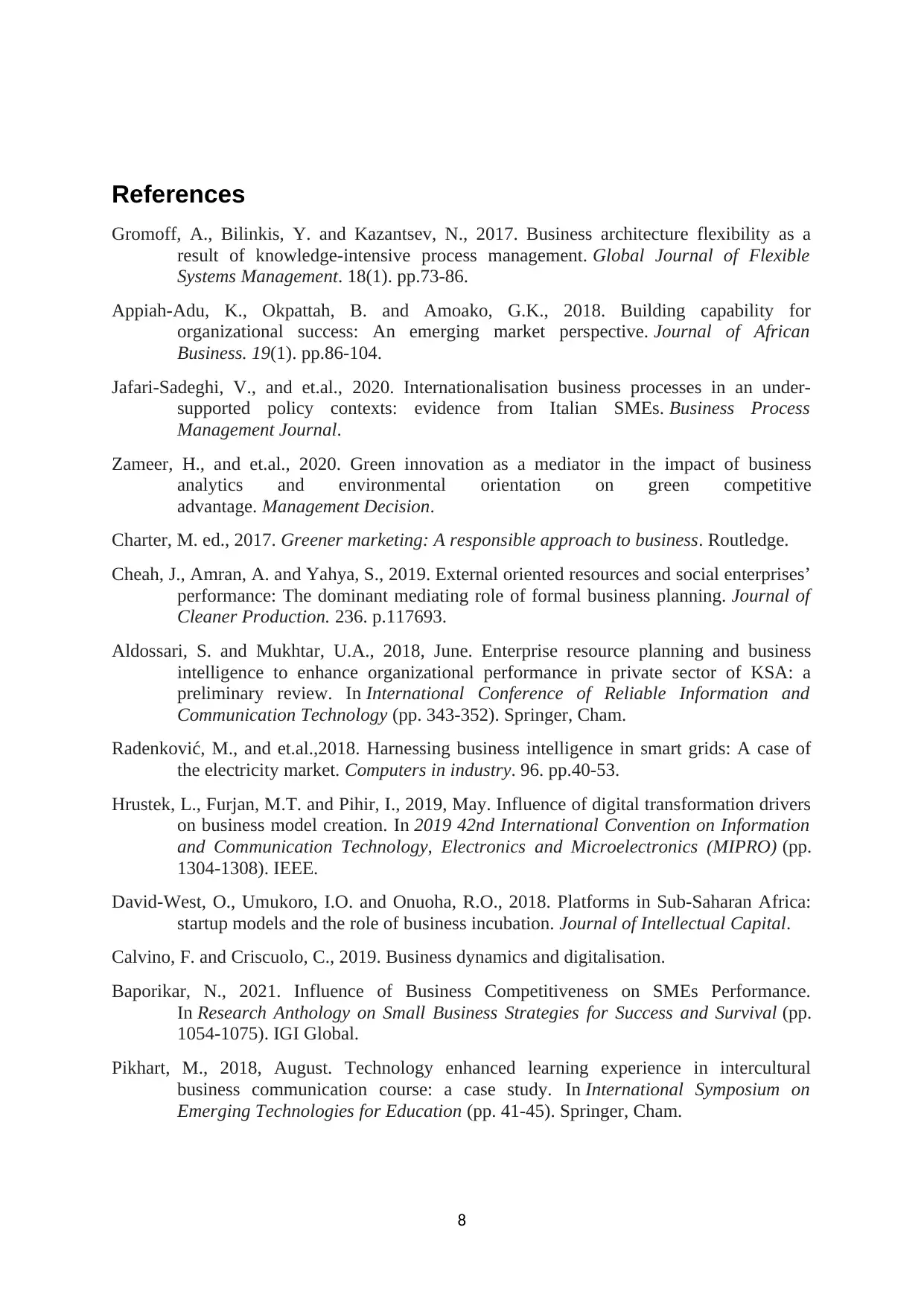
References
Gromoff, A., Bilinkis, Y. and Kazantsev, N., 2017. Business architecture flexibility as a
result of knowledge-intensive process management. Global Journal of Flexible
Systems Management. 18(1). pp.73-86.
Appiah-Adu, K., Okpattah, B. and Amoako, G.K., 2018. Building capability for
organizational success: An emerging market perspective. Journal of African
Business. 19(1). pp.86-104.
Jafari-Sadeghi, V., and et.al., 2020. Internationalisation business processes in an under-
supported policy contexts: evidence from Italian SMEs. Business Process
Management Journal.
Zameer, H., and et.al., 2020. Green innovation as a mediator in the impact of business
analytics and environmental orientation on green competitive
advantage. Management Decision.
Charter, M. ed., 2017. Greener marketing: A responsible approach to business. Routledge.
Cheah, J., Amran, A. and Yahya, S., 2019. External oriented resources and social enterprises’
performance: The dominant mediating role of formal business planning. Journal of
Cleaner Production. 236. p.117693.
Aldossari, S. and Mukhtar, U.A., 2018, June. Enterprise resource planning and business
intelligence to enhance organizational performance in private sector of KSA: a
preliminary review. In International Conference of Reliable Information and
Communication Technology (pp. 343-352). Springer, Cham.
Radenković, M., and et.al.,2018. Harnessing business intelligence in smart grids: A case of
the electricity market. Computers in industry. 96. pp.40-53.
Hrustek, L., Furjan, M.T. and Pihir, I., 2019, May. Influence of digital transformation drivers
on business model creation. In 2019 42nd International Convention on Information
and Communication Technology, Electronics and Microelectronics (MIPRO) (pp.
1304-1308). IEEE.
David-West, O., Umukoro, I.O. and Onuoha, R.O., 2018. Platforms in Sub-Saharan Africa:
startup models and the role of business incubation. Journal of Intellectual Capital.
Calvino, F. and Criscuolo, C., 2019. Business dynamics and digitalisation.
Baporikar, N., 2021. Influence of Business Competitiveness on SMEs Performance.
In Research Anthology on Small Business Strategies for Success and Survival (pp.
1054-1075). IGI Global.
Pikhart, M., 2018, August. Technology enhanced learning experience in intercultural
business communication course: a case study. In International Symposium on
Emerging Technologies for Education (pp. 41-45). Springer, Cham.
8
Gromoff, A., Bilinkis, Y. and Kazantsev, N., 2017. Business architecture flexibility as a
result of knowledge-intensive process management. Global Journal of Flexible
Systems Management. 18(1). pp.73-86.
Appiah-Adu, K., Okpattah, B. and Amoako, G.K., 2018. Building capability for
organizational success: An emerging market perspective. Journal of African
Business. 19(1). pp.86-104.
Jafari-Sadeghi, V., and et.al., 2020. Internationalisation business processes in an under-
supported policy contexts: evidence from Italian SMEs. Business Process
Management Journal.
Zameer, H., and et.al., 2020. Green innovation as a mediator in the impact of business
analytics and environmental orientation on green competitive
advantage. Management Decision.
Charter, M. ed., 2017. Greener marketing: A responsible approach to business. Routledge.
Cheah, J., Amran, A. and Yahya, S., 2019. External oriented resources and social enterprises’
performance: The dominant mediating role of formal business planning. Journal of
Cleaner Production. 236. p.117693.
Aldossari, S. and Mukhtar, U.A., 2018, June. Enterprise resource planning and business
intelligence to enhance organizational performance in private sector of KSA: a
preliminary review. In International Conference of Reliable Information and
Communication Technology (pp. 343-352). Springer, Cham.
Radenković, M., and et.al.,2018. Harnessing business intelligence in smart grids: A case of
the electricity market. Computers in industry. 96. pp.40-53.
Hrustek, L., Furjan, M.T. and Pihir, I., 2019, May. Influence of digital transformation drivers
on business model creation. In 2019 42nd International Convention on Information
and Communication Technology, Electronics and Microelectronics (MIPRO) (pp.
1304-1308). IEEE.
David-West, O., Umukoro, I.O. and Onuoha, R.O., 2018. Platforms in Sub-Saharan Africa:
startup models and the role of business incubation. Journal of Intellectual Capital.
Calvino, F. and Criscuolo, C., 2019. Business dynamics and digitalisation.
Baporikar, N., 2021. Influence of Business Competitiveness on SMEs Performance.
In Research Anthology on Small Business Strategies for Success and Survival (pp.
1054-1075). IGI Global.
Pikhart, M., 2018, August. Technology enhanced learning experience in intercultural
business communication course: a case study. In International Symposium on
Emerging Technologies for Education (pp. 41-45). Springer, Cham.
8
⊘ This is a preview!⊘
Do you want full access?
Subscribe today to unlock all pages.

Trusted by 1+ million students worldwide

Daidj, N. and Egert, C., 2018. Towards new coopetition-based business models? The case of
Netflix on the French market. Journal of Research in Marketing and
Entrepreneurship.
Daradkeh, M. and Moh'd Al-Dwairi, R., 2018. Self-service business intelligence adoption in
business enterprises: the effects of information quality, system quality, and analysis
quality. In Operations and Service Management: Concepts, Methodologies,
Tools, and Applications (pp. 1096-1118). IGI Global.
9
Netflix on the French market. Journal of Research in Marketing and
Entrepreneurship.
Daradkeh, M. and Moh'd Al-Dwairi, R., 2018. Self-service business intelligence adoption in
business enterprises: the effects of information quality, system quality, and analysis
quality. In Operations and Service Management: Concepts, Methodologies,
Tools, and Applications (pp. 1096-1118). IGI Global.
9
Paraphrase This Document
Need a fresh take? Get an instant paraphrase of this document with our AI Paraphraser
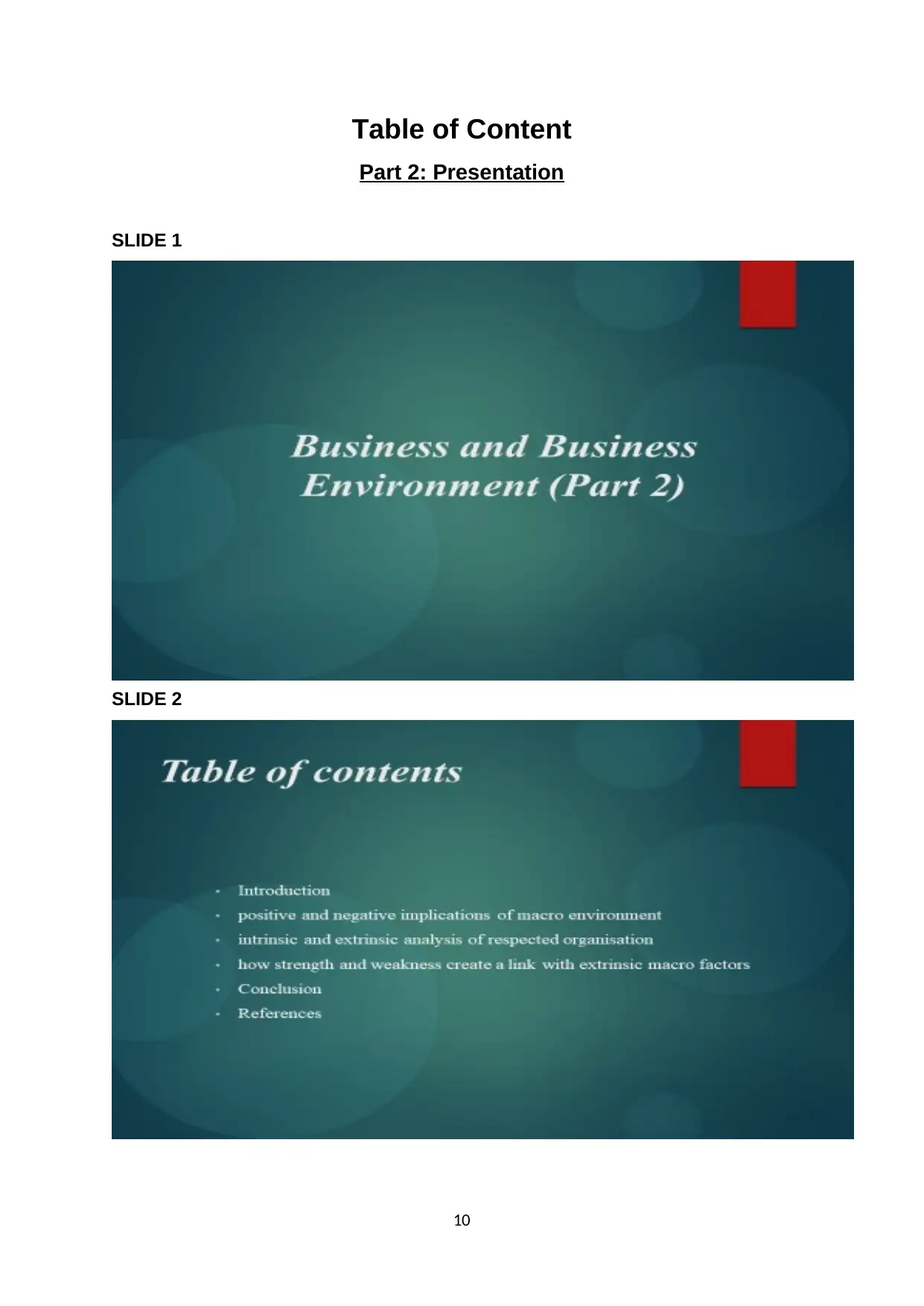
Table of Content
Part 2: Presentation
SLIDE 1
SLIDE 2
10
Part 2: Presentation
SLIDE 1
SLIDE 2
10
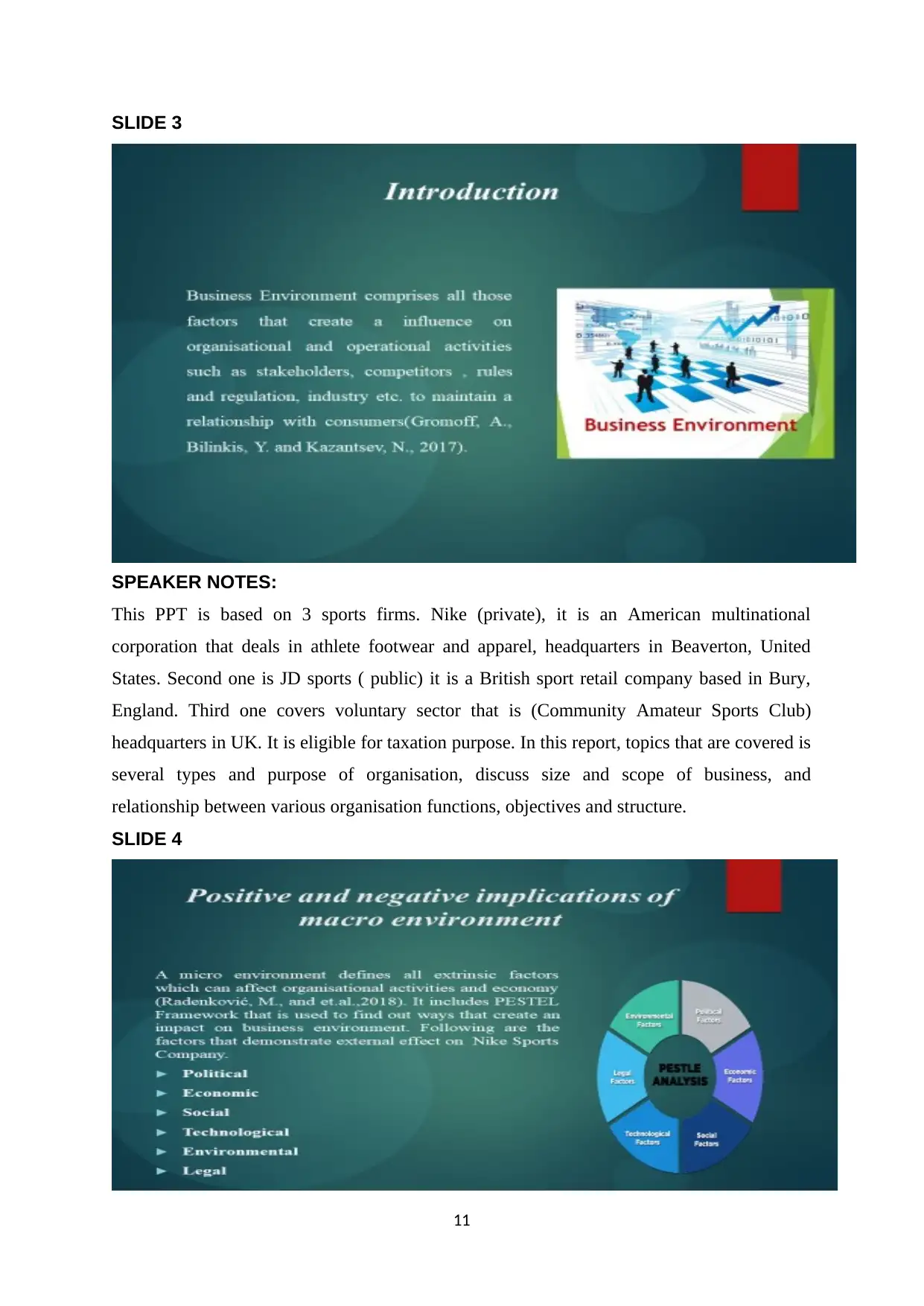
SLIDE 3
SPEAKER NOTES:
This PPT is based on 3 sports firms. Nike (private), it is an American multinational
corporation that deals in athlete footwear and apparel, headquarters in Beaverton, United
States. Second one is JD sports ( public) it is a British sport retail company based in Bury,
England. Third one covers voluntary sector that is (Community Amateur Sports Club)
headquarters in UK. It is eligible for taxation purpose. In this report, topics that are covered is
several types and purpose of organisation, discuss size and scope of business, and
relationship between various organisation functions, objectives and structure.
SLIDE 4
11
SPEAKER NOTES:
This PPT is based on 3 sports firms. Nike (private), it is an American multinational
corporation that deals in athlete footwear and apparel, headquarters in Beaverton, United
States. Second one is JD sports ( public) it is a British sport retail company based in Bury,
England. Third one covers voluntary sector that is (Community Amateur Sports Club)
headquarters in UK. It is eligible for taxation purpose. In this report, topics that are covered is
several types and purpose of organisation, discuss size and scope of business, and
relationship between various organisation functions, objectives and structure.
SLIDE 4
11
⊘ This is a preview!⊘
Do you want full access?
Subscribe today to unlock all pages.

Trusted by 1+ million students worldwide
1 out of 19
Related Documents
Your All-in-One AI-Powered Toolkit for Academic Success.
+13062052269
info@desklib.com
Available 24*7 on WhatsApp / Email
![[object Object]](/_next/static/media/star-bottom.7253800d.svg)
Unlock your academic potential
Copyright © 2020–2025 A2Z Services. All Rights Reserved. Developed and managed by ZUCOL.


